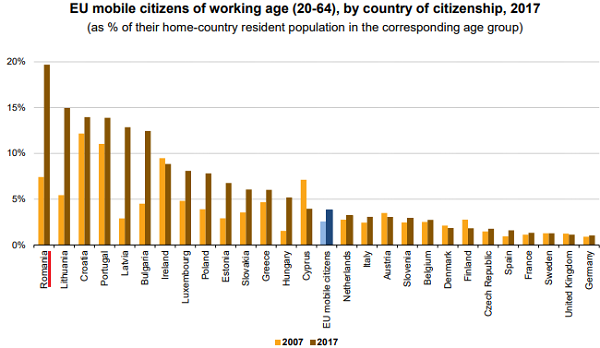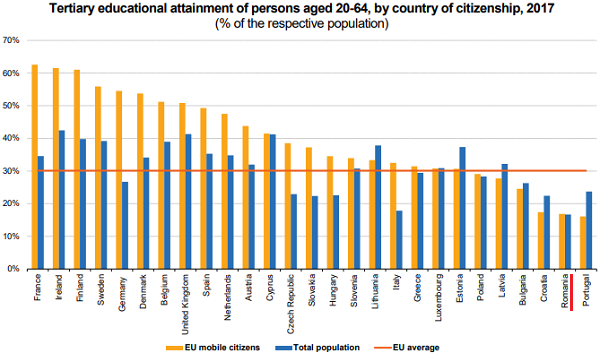The share of Romanians who left abroad in the total active population (aged between 20-64) almost tripled in 10 years – from 7.5% in 2007, this category expanded to 19.7% in 2017, according to a Eurostat analysis.
Romania is the EU country with the highest percentage of the active population working in another member state. The European average is 3.8% of the total population aged between 20-64.
The following positions are held by Lithuania (15.0%), Croatia (14.0%), Portugal (13.9%), Latvia (12.9%) and Bulgaria (12.5%). All are countries where the average salary is much lower than in Western Europe.
At the other end are the citizens of the rich states of the Union: Germany (where the mobile population represents only 1.0% of the total active population), the UK (1.1%), Sweden and France (with a share of 1.3% each, between 20 and 64):
Romania – share of university graduates in the total of those who went abroad, similar to the share of those who remained at home
Eurostat data reflects two different behaviours – much more people with higher education leave from wealthy EU states to work in another member country – either to establish their own business or to represent companies from their own country or multinationals. Therefore, the share of people with higher education within the mobile population is much higher than the percentage of those with higher education in the total population of the state they left.
This could mean that the main reason for choosing a job abroad is the career. For those from Eastern Europe, emigration is mainly motivated by a much more attractive salary.
In the case of French people, 62.5% of those who accepted to work abroad have higher education, compared to 34.6%, the share of higher education graduates in the total population of France (a difference of 27.9 percentage point).
The largest difference between the percentages recorded by the higher education graduates in the two categories is recorded in Germans’ case – 54.5% people with higher education in the mobile population and 26.76% of the resident population, which represents a difference of 28 percentage points).
For six states, the situation is opposite – graduates have a higher share in the resident population than in the emigrants’ category – Bulgaria, Croatia, Portugal and the three Baltic countries (Latvia, Estonia and Lithuania).
In Romania’s case, the two shares are similar:
At the EU level, the share of people with higher education of active citizens living outside the member states exceeds by 2.3 percentage points the share of the active population with tertiary education in the resident population.












